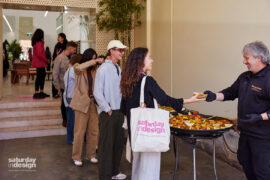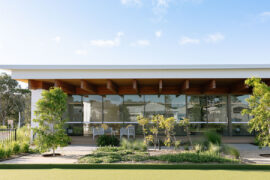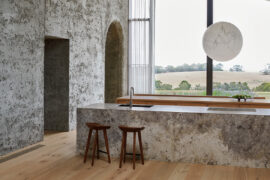In our sister magazine Cubes #85, we ask: Is the food court all it could be? Kuala Lumpur-based design collective Karya suggests we should lift our expectations and demand a better experience from these ubiquitous environments.
We may be reticent to admit it when we’re calorie starved and comfortable at home at the end of a long day, but app-based ordering and the private consumption of restaurant food are of course playing a part in eroding familiar social exchanges and opportunities for an enriching experience of the city. Soon, the basic human exchange of greeting a delivery rider may even be out of the equation; US company Starship Technologies has recently activated small six-wheeled semi-autonomous robots for the delivery of food orders in Washington DC and Redwood City, California.
Are we at risk of too easily forgetting the cohesive value of social exchanges and shared experiences of place? City Dining Room is a speculative project by Malaysian studio Karya that tackles the mall food court – a typically one-dimensional space for the consumption of economical food – and investigates it as a shared site that can perhaps deliver more than we give it credit for.
Karya is a design collective consisting of Ashran Bahari, Naadiya Hani, Mior Aizuddin, Hazazi Hamzah, Faiz Pazanon, Mohd Helmy and Dhaniah Samad. In their view, the Malaysian food court typology is thought about in a flawed way. It has been naively associated, they say, with a place where people can consume affordable food in a very ‘functional’ (read: cheap) and banal setting. Things are stripped to their minimum to serve a maximum function: eat and go, as quickly as possible. But the experiential aspects of meeting and eating have not been properly considered, and the functional typology is therefore inadequate.
Additionally, says Karya, dining spaces in a typical Malaysian shopping mall setting are segregated into different categories: conventional food courts, franchised F&B outlets, and high-end restaurants. “We feel that this could be reorganised and redesigned using a more inclusive approach. The whole exercise should then centre on providing a better place for people to meet and eat,” they say. At the heart of the City Dining Room concept is the notion that since they can be visible, accessible and available, food courts could encapsulate an atmosphere similar to that generated by street food vendors – which have traditionally been common not only in Malaysia but in many places around the world.
City Dining Room proposes the expansion and reinvention of an existing mall food court as an irregularly edged ‘street’ beneath an atrium. The analogy to a street grew from Karya’s perception of the ‘commons’ of a city (its streets, alleys and parks – that is, its shared public environments) as neutral spaces for social interaction that do not represent the identity of any particular entity. For Karya, food courts constitute part of the city’s commons. “While they don’t represent the primary landmarks that give identity to a city, they are the places where you can see the most important element of a city: its people,” say the designers.
City Dining Room was designed around the notion of meeting and eating. The goal was to attract people to occupy and interact within the space, hence the colonisation of a far more visible stretch of the mall interior – its corridors and circulation routes. City Dining Room is therefore more ‘food street’ than ‘food court’. Nodes, anchored by pavilions with natural vegetation, were designed to encourage people to linger and appreciate the colours, sounds and smells of cooking. And for in-between spaces, activity zones have been suggested such as a playground and informal beanbag seating.
It is an attempt at urbanising and variegating a typically underperforming space, with the underpinning of a neutral and anti-iconic grid – an element that Karya explored in a real-life installation in a Kuala Lumpur mall late last year. Karya worked in collaboration with Normal Architecture to develop a tall gridded frame that anchored a gathering point within Wisma Central for the designer-maker showcase called Neue Artisans 4.0. The grid was monumental, say the designers, but anti-iconic – it was an indexing device and a background for other spaces and events.
Read more in Cubes 85!
INDESIGN is on instagram
Follow @indesignlive
A searchable and comprehensive guide for specifying leading products and their suppliers
Keep up to date with the latest and greatest from our industry BFF's!

London-based design duo Raw Edges have joined forces with Established & Sons and Tongue & Groove to introduce Wall to Wall – a hand-stained, “living collection” that transforms parquet flooring into a canvas of colour, pattern, and possibility.

Welcomed to the Australian design scene in 2024, Kokuyo is set to redefine collaboration, bringing its unique blend of colour and function to individuals and corporations, designed to be used Any Way!
Cutler & Co present a design dinner and discussion with Oron Catts, director of SymbioticA and recently listed by Icon Magazine as one of 20 designers influencing the future. Catts will speak about his work as the co-founder of SymbioticA at the Centre of Excellence in Biological Arts at the University of Western Australia as […]
Australia was one of the world’s first countries to ban the importation of the incandescent light bulb. In recent times we have seen an explosion in lighting products aimed at replacing the incandescent lamp. At first there were compact fluorescent lamps, and now there is a credible LED alternative with high efficiency, dimming, nice colour […]
The internet never sleeps! Here's the stuff you might have missed

Collingwood pulsed with energy at Saturday Indesign 2025, where talks, launches and activations spilled from showrooms into the streets.

Designed by DKO, the latest Ingenia Lifestyle Element resident clubhouses at Fullerton Cove and Natura at Port Stephens focus on the lifestyle needs of a changing over-55s demographic.

The INDE.Awards 2025 has named House on a Hill by Leeton Pointon Architects and Allison Pye Interiors as the winner of The Interior Space category, presented by Tongue & Groove. This multigenerational country home on Bunurong Country redefines residential architecture and design with its poetic balance of form, function, and sanctuary.